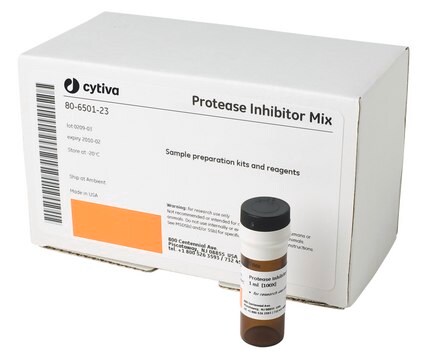P8849
Protease Inhibitor Cocktail
DMSO solution, for the inhibition of serine, cysteine, aspartic, aminopeptidases and thermolysin-like activities, for use in purification of Histidine-tagged proteins, DMSO solution
Synonym(s):
Protease inhibitor solution
About This Item
Recommended Products
Product Name
Protease Inhibitor Cocktail, for use in purification of Histidine-tagged proteins, DMSO solution
biological source
synthetic
Quality Level
form
DMSO solution
solubility
water: soluble
storage temp.
−20°C
Looking for similar products? Visit Product Comparison Guide
Related Categories
General description
The cocktail contains a mixture of inhibitors that specifically target serine, cysteine, aspartic, and thermolysin-like proteases, and aminopeptidases.
Specificity
Application
It is recommended for inhibition of protease activity in 100 mL of cell lysate from 20 g of Escherichia coli or 10 g of baculovirus-infected Spodoptera frugiperda pupal ovary cells.
Features and Benefits
Targets multiple types of proteases, ensuring comprehensive inhibition of protease activity.
Compatibility with IMAC applications due to omission of chelating agents.
Supplied in convenient packaging options.
Components
Bestatin
E-64
Pepstatin A
Phosphoramidon
Quantity
This protease inhibitor cocktail has been optimized and tested for histidine-tagged proteins
Preparation Note
related product
Storage Class
10 - Combustible liquids
wgk_germany
WGK 1
flash_point_f
185.0 °F - closed cup
flash_point_c
85 °C - closed cup
Choose from one of the most recent versions:
Certificates of Analysis (COA)
Don't see the Right Version?
If you require a particular version, you can look up a specific certificate by the Lot or Batch number.
Already Own This Product?
Find documentation for the products that you have recently purchased in the Document Library.
Customers Also Viewed
Related Content
Select different protease inhibitor types based on your needs to prevent protein degradation during isolation and characterization and safeguard proteins in sample prep.
Our team of scientists has experience in all areas of research including Life Science, Material Science, Chemical Synthesis, Chromatography, Analytical and many others.
Contact Technical Service

















